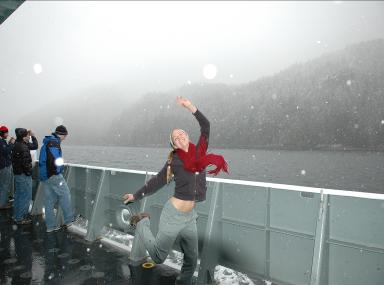
|
Click on the question mark to ask the class about oceanography, Glacier Bay, or the cruise. Your question and answer will appear on the Questions page under Quick Links. |

|
8:00 AM Due to some problems with our internet connection the complete March 15 blog was not posted until the morning of March 16. Click on the March 15 link at left for more pictures of the Inside Passage and some information on how ships are able to navigate the narrow corridor.
-Jeff
|
|
March 16, 2008 |


|
11:00 AM We have officially been at sea for 36 hours and so far it’s been smooth sailing. The most stressful part of the cruise so far has been waking up early enough to make it to breakfast! Actually I missed breakfast today because the ship was rockin’ last night and I don’t mean party central. We hit some open water during the night and as the ship swayed back and forth and I definitely felt it on my top bunk. If you’ve never felt the swaying of the ship here’s an analogy for you: Think of feeling a little turbulence on a plane, it doesn’t feel good, it makes you a little uneasy, and you really hope the pilot has it under control.
In terms of science we had our hazardous chemicals (haz-mats in ship lingo) checked off yesterday. We are all clear and ready to do “safe and clean science”. We also watched a short video on Glacier Bay after lunch. The scenery was beautiful and I cannot wait to get there.
Right now you can find most of us studying for finals in various parts of the ship. That’s right, finals. I hope mine doesn’t accidentally blow off the ship…
Thanks for reading and look for more coming soon…
-Christine
|


|
The class gathers in the TV lounge to watch a video on Glacier Bay. |

|
“Yay, snow!”. April celebrates the weather. |
|
2:15 PM With only a day and a half to go until we reach our first “station” (data collection point) in Glacier Bay we’re still hammering out the cruise plan and prepping gear. The cruise plan gets worked out to the last detail to avoid even minutes long delays at each site.
Complicating the science plan are logistical considerations, weather and navigation will come into play in the tight quarters of Glacier Bay. Several stations will need to be visited more than once, to retrieve deployed gear. The first visit to many of these stations has to be made in the daylight, to allow the ship’s Captain and crew a chance to familiarize themselves with the layout of glaciers and other potential hazards. With only so many hours of daylight in the first half of the visit time will get very short. Despite its level of detail the cruise plan has to remain flexible. Science time may be gained or lost as a result of factors outside the control of the crew or science party.
To increase efficiency and maximize time the students are organized into three watches. This is the “zone defense” approach to data collection. Scheduled research (CTD casts, cores, net tows, etc.) will be carried out by the appropriate watch, rather than by the researcher for whom data is being collected (although you can expect student researchers to be anxiously on hand as their key data points come aboard, schedule or not!). This also insures that the physical oceanographers come out of the computer lab and get wet and muddy on the deck...
-Jeff
|

|
The Thompson cruises past islands hidden in the falling snow. |

|
Quick Links
Senior Thesis Research Course, Ocean 444
Senior Thesis Planning Course, Ocean 443
Quick Links to Blog Entries
|
|
Glacier Bay banner background image by Andy Cameron, see original image. Send mail to: seniorcruise2008@ocean.washington.edu |